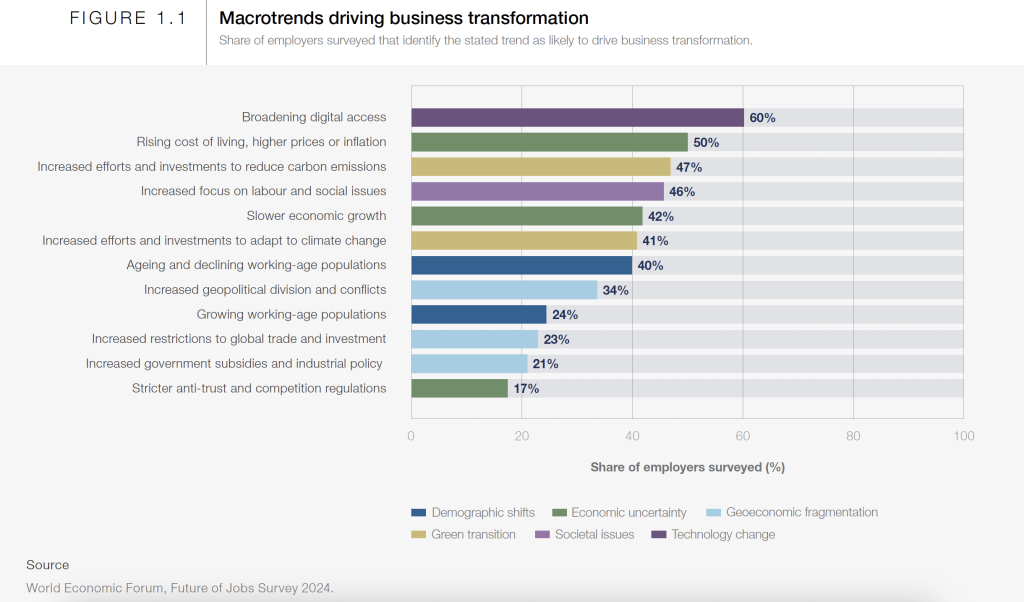Ascent Group and Oxford Process Excellence expand collaboration for building AI capabilities
June 18, 2025Adela Cristea
Ascent Group and Oxford Process Excellence strengthen their strategic partnership started in 2023.
READ MOREAccording to the World Economic Forum’s “Future of Jobs” report from 2025, the aging population is increasing the demand for professionals in various fields and putting pressure on employers to specialize their employees.
Read articleOver the past year, we have noticed growing interest among our clients in summary resources, such as reports that analyze current trends and offer guidance for the future. These resources are valuable tools for both personal planning and strategic guidance for companies. In a context marked by rapid changes in society, the economy, and the business environment, such exercises become essential for a balanced approach to the present and the future.
A telling example is the “Future of Jobs Report 2025,” published by the World Economic Forum, now in its fifth edition. It provides an in-depth analysis of anticipated transformations in the labor market through 2030, highlighting major trends and emerging challenges.
The report is not limited to presenting simple statistical data, but offers an integrated and well-documented vision that facilitates the identification of robust strategic directions to address labor market trends in a constructive manner.
This article aims to analyze one of the macro-trends influencing labor market transformations: aging and declining work-age populations. This trend will bring significant challenges to the forefront in the coming years, such as a lack of specialized skills and resistance to change. Here is how it appears alongside other relevant macro-trends:

One of the effects of these realities is that the skills gap in the labor market continues to represent a major obstacle to transformation, according to 63% of respondents in the above-mentioned survey. This percentage is even higher than that highlighted in the 2023 edition of the report, when 60% of respondents identified the skills gap as a major problem.
This challenge persists in almost all sectors and geographical areas included in the study, ranking first in 52 of the 55 economic areas analyzed, as well as in 19 of the 22 sectors of activity evaluated.
In addition to these macroeconomic trends, the report also presents the eight most important areas that require priority attention in order to avoid bottlenecks in organizational growth:
In this context, another important report published by Udemy Business, entitled “Gen Z in the Workplace”, highlights the proportion of generations in the workforce. According to the report, Generation Z (those born between 1997 and 2012) will represent approximately one-third of the global population and 27% of the workforce in 2025. By 2035, they are expected to become the predominant group of employees worldwide. The most encouraging aspect is that, according to the report, 65% of employees in this age group are eager to learn and develop in their roles. In addition, 84% of them consider soft skills to be crucial for professional success.
Here is how the representatives of this generation perceive themselves in relation to their ability to successfully integrate and perform at work:
Understanding the motivations, preferences, and needs of this generation is becoming an increasingly urgent priority for companies that want to remain competitive. (An authoritative voice on issues related to intergenerational dynamics in the workplace is Dr. Eliza Filby, who in this article draws attention to one of the facets of these new realities, namely age discrimination in the workplace.) As for companies, investing in training, education, and the development of a sustainable organizational culture is key to attracting, engaging, and retaining Generation Z representatives, thus ensuring the long-term growth and success of organizations.
Strategies for strengthening the highly skilled workforce that take into account the practices reflected in the chart above will be those that succeed in sustaining healthy and lasting organizational cultures. Thus, some keys to continuous team performance can be found in:
Promoting continuous learning: developing comprehensive training programs that target a wide range of skills, ensuring that employees are equipped with the know-how to achieve business objectives.
Cultivating an inclusive development environment: encouraging intergenerational collaboration, enabling the transfer of information, the exchange of perspectives, and mentoring through which teams can innovate.
Use of technology: using digital platforms and solutions to make training opportunities more flexible and accessible, offering a wide range of options tailored to mixed groups with different preferences and learning styles.
Implementing active change management: implementing strategies to support employees in navigating change, with a focus on benefits and available support structures.
In a world where the only constant is change, by adopting a flexible, inclusive organizational culture with a focus on continuous improvement, companies can accustom employees to a climate where change is associated with opportunities.